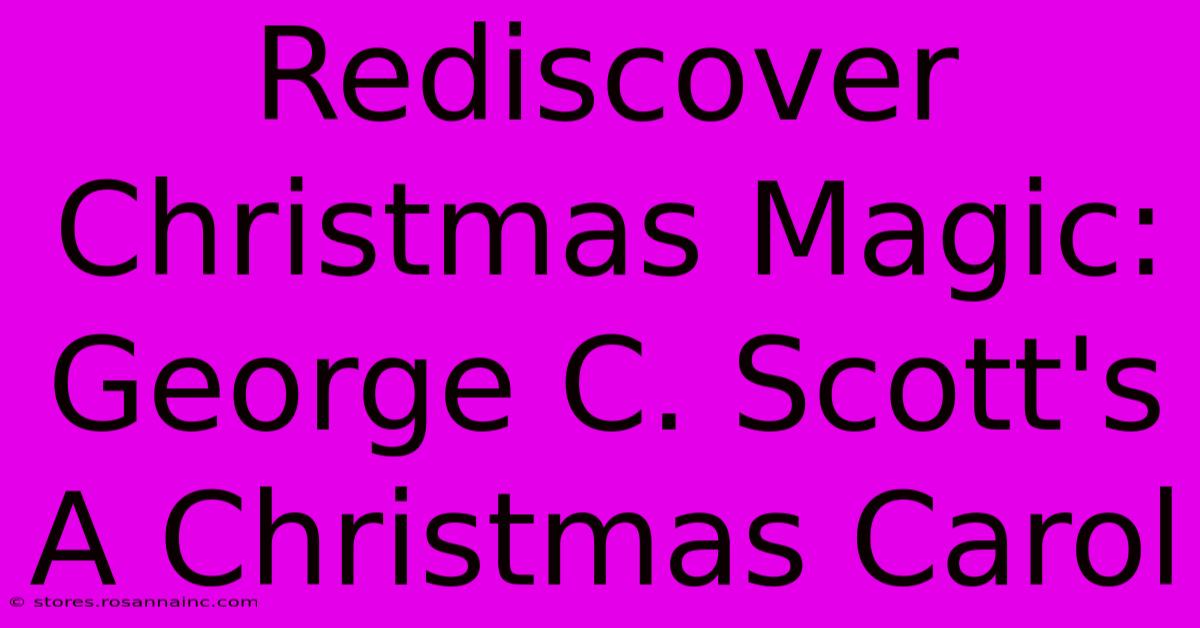Rediscover Christmas Magic: George C. Scott's A Christmas Carol

Table of Contents
Rediscover Christmas Magic: George C. Scott's A Christmas Carol
The holiday season wouldn't be complete without a revisit to the timeless tale of Ebenezer Scrooge. While numerous adaptations of Charles Dickens' A Christmas Carol exist, George C. Scott's 1984 version stands out as a particularly potent and memorable rendition. This isn't your typical, saccharine Christmas special; it's a powerful, often unsettling, and ultimately deeply moving exploration of redemption. This article will delve into what makes this adaptation so special and why it's worth rediscovering this Christmas.
A Scrooge for the Ages: George C. Scott's Performance
George C. Scott's portrayal of Ebenezer Scrooge is legendary. He embodies the character's miserly nature with a chilling intensity, making his eventual transformation all the more impactful. Scott doesn't shy away from Scrooge's unpleasant traits; he embraces them fully, creating a truly believable and unlikeable protagonist. This nuanced performance is crucial to the film's success. We're not simply watching a caricature of a miser; we're witnessing a complex, broken man slowly piecing himself back together. His gruff voice, his piercing gaze, and his subtle shifts in demeanor as the ghosts visit are masterful. It's a performance that stays with you long after the credits roll.
More Than Just a Grumpy Old Man
What makes Scott's portrayal so effective is its avoidance of simplistic good versus evil tropes. He doesn't portray Scrooge as simply evil; he shows us the years of hardship and emotional repression that have hardened his heart. We see glimmers of humanity peeking through even in his most miserly moments, making his eventual redemption all the more earned and deeply satisfying. This depth of character is rarely seen in other adaptations.
A Faithful Adaptation with a Unique Vision
While remaining true to the spirit of Dickens' original novella, this adaptation takes certain creative liberties that enhance the storytelling. The pacing is deliberate, allowing the audience to fully absorb the weight of Scrooge's journey. The cinematography utilizes shadows and lighting to emphasize the stark contrast between Scrooge's bleak world and the hopeful visions presented by the ghosts. The score, too, contributes to the film's overall atmosphere, shifting from somber to hopeful as Scrooge undergoes his transformation.
The Ghosts: Powerful and Unforgettable
The ghosts themselves are chillingly effective. The Ghost of Christmas Past isn't simply a nostalgic figure; it's a force that confronts Scrooge with the choices he's made and the opportunities he's missed. The Ghost of Christmas Present, while jovial, carries a weight of responsibility, showing Scrooge the suffering of those around him. And finally, the Ghost of Christmas Yet to Come is terrifyingly realistic, presenting a bleak future without redemption. These aren't whimsical apparitions; they are powerful forces of nature driving Scrooge towards his change of heart.
Why Rediscover A Christmas Carol (1984)?
In a world saturated with holiday cheer, this version offers a refreshing, darker perspective on the classic tale. It's a reminder that Christmas isn't just about tinsel and presents; it's about reflection, redemption, and the importance of human connection. This adaptation is perfect for those who appreciate a more mature and thought-provoking take on the story, one that prioritizes character development and emotional depth over simple sentimentality. It's a film that will resonate with audiences of all ages, offering a timeless message of hope and second chances.
This Christmas, give yourself the gift of rediscovering the magic of A Christmas Carol, as presented through the unforgettable performance of George C. Scott. You won't regret it.

Thank you for visiting our website wich cover about Rediscover Christmas Magic: George C. Scott's A Christmas Carol. We hope the information provided has been useful to you. Feel free to contact us if you have any questions or need further assistance. See you next time and dont miss to bookmark.
Featured Posts
-
Uncover The Secrets Of Rosemary Sutcliffs The Shield Ring
Feb 09, 2025
-
Carry A Big Stick Project Confidence And Achieve Your Goals
Feb 09, 2025
-
Italie Victorieuse Face Au Pays De Galles
Feb 09, 2025
-
Caribbean Earthquake Islands On Alert
Feb 09, 2025
-
Actor Tony Roberts Dead At 85
Feb 09, 2025
